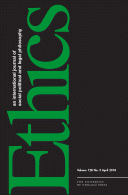

We’re pleased to announce our next Ethics review forum on John Oberdiek’s Imposing Risk: A Normative Framework (OUP 2017), reviewed by Madeleine. Excerpts from the blurb and the review are below, but you can read both in their entirety via OUP’s website and Ethics, respectively. (Though of course, you are welcome to participate in the forum even if you haven’t read either.)
The forum will start on the morning of Friday April 12.
The book abstract:
Human life has always been shadowed by risks like disease and natural disaster, but modern life is distinctively risky. The risks we now face are morally cognizable. For they are, in the main, subject to our control—indeed, they are typically our creation. The risks that define modern life are therefore our responsibility. As they are largely imposed by people on people, they call for moral assessment. This book addresses some of the central questions stimulated by our contemporary practices of imposing risk, including the nature of risk, as the concept is employed in a normative framework of risk imposition; the moral signifiance of imposing risk on others; the possibility of a right against risking; and the moral standards governing the imposition of risk on others.
From the review:
What, if anything, makes the imposition of a risk on another person morally significant? What, if anything, would determine the permissibility of such an imposition? Do we have individual rights not to have risks imposed upon us? These questions have been at the forefront of the ethics of risk literature for some time. They also lie at the heart of this book. Oberdiek addresses these moral aspects of risk impositions from a perspective drawing on legal philosophy, tort law theory, rights theory, Razian ideas on autonomy and reasons, Scanlonian contractualism and morality framed in terms of what we can reasonably justify to each other. This adds a new flavor to the largely consequentialist, cost-benefit, and rights-based treatments that have come to dominate much of the ethics of risk literature. […]
What property is it that makes the mere risk of harm morally problematic and, presumably, in some cases impermissible? According to Oberdiek, it cannot be that the fact that it “portends to harm.” Nor can it be that a risk imposed is a harm, at least not in any direct material sense. Central to this framing of the problem is that, “[i]f imposing pure risks is morally significant it means that the imposition of risk as such is a proper object of moral assessment, calling for justification, such that any risk imposition is a candidate wrong and potentially impermissible” (68ff.). […] The position he defends is that risk impositions are morally significant in their own right, even when harm does not result, and that they are so because of their negative impact on the lives of those they affect. Risk impositions are significant owing to the real, but immaterial, harm they can cause. In particular, they can diminish autonomy as a core interest. […]
One of the arguments for this idea comes by way of an analogy: To impose risks is comparable to laying out traps for another. A person may never fall into the traps laid down but would be restricted by the fact that they were there.
“I have argued that the distinctive and primary moral significance of imposing risk on others lies in the effect that risk has on the autonomy of those subject to it. Autonomy requires a variety of worthwhile options, but when one is subject to risk, certain of those options are foreclosed. Just as a trap can diminish the autonomy of the one threatened by it, even if it never snares the would-be victim, risks that do not end up causing material harm to anyone nevertheless can curtail the autonomy of those in the orbit of the risk.” (131).
[…]Is “autonomy” the right place to look for the moral significance of risk impositions? There are at least three worries that come to mind. First, not all morally problematic risks imposed seem to affect autonomy negatively. Consider someone connecting two remote regions by building a rickety rope bridge across a deep gorge. It is hard to see that the bridge would foreclose any options, choice-worthy or otherwise. My unease with this is that many cases of risk impositions are of this type: They add more, but risky, options—and sometimes only in competition with other unsafe or directly harmful alternatives. Risk impositions cannot be morally significant only when they consist in a worsening of a situation against a background of pre-existing safety. Take unsafe migrant boat rides offered to migrants as escape routes by human smugglers. It would seem that what makes such risks morally significant is precisely that they portend to harm, even when they do not lead to death, rather than that they foreclose some hypothetical safer option that is not on offer. Second, not all morally problematic risk impositions seem to affect autonomy or autonomous agents. If risk impositions were problematic only in those cases where autonomy is affected, this would considerably narrow the class of potentially morally significant risks. Themoral significance related to climate change risks, risks imposed on children, or risks imposed on someone in a coma, to borrow Placani’s example, would all require a different explanation (Adriana Placani, “When the risk of harm harms,” Law and Philosophy 36 [2017] 77-100). Third, if autonomy singles out what is morally significant about acts of risk imposition, then this would also presumably point to a defining difference between acts that impose a risk of harm, on the one hand, and acts that mitigate or counteract harm, on the other. However, many acts to contain, mitigate, or prevent risks affect autonomy negatively and sometimes to a greater degree than the risk imposition itself. For example, issuing a curfew when there are high levels of air pollution obviously forecloses options to those affected by the curfew, in particular whether they are allowed to decide freely whether to go outside. This seems to hold generally: Most cases of regulation and mitigation of risk diminish autonomy in obvious ways, whereas the risk itself does so to a much lesser degree.

